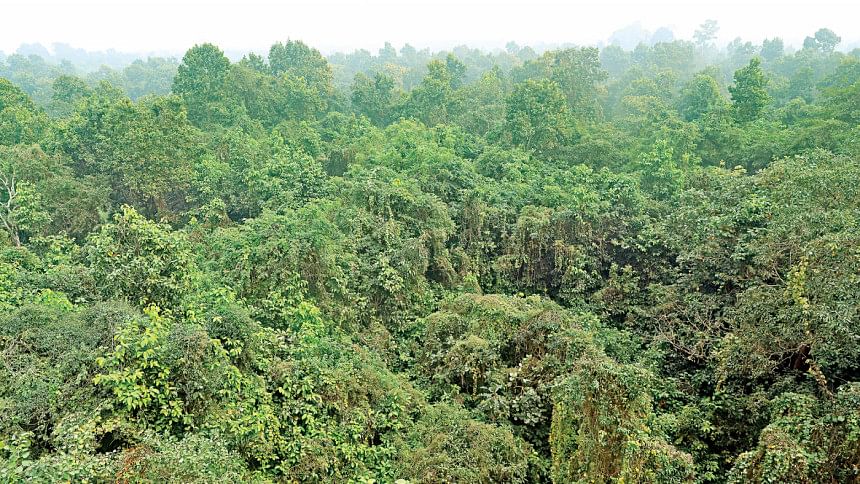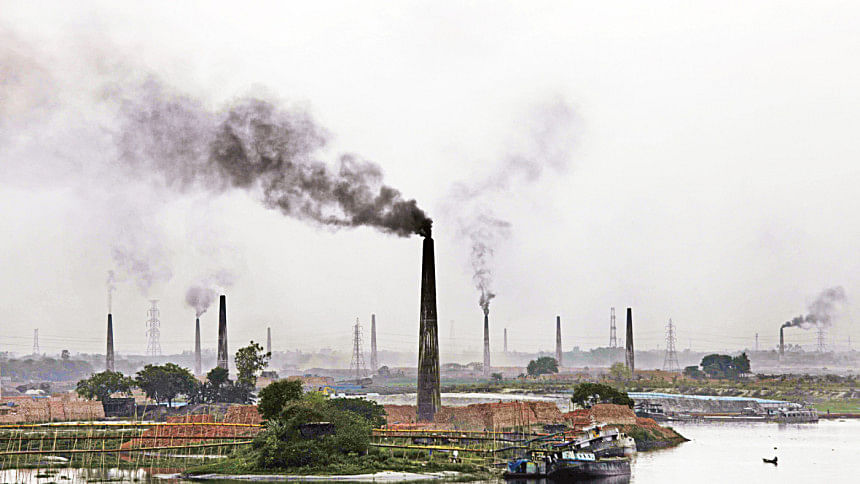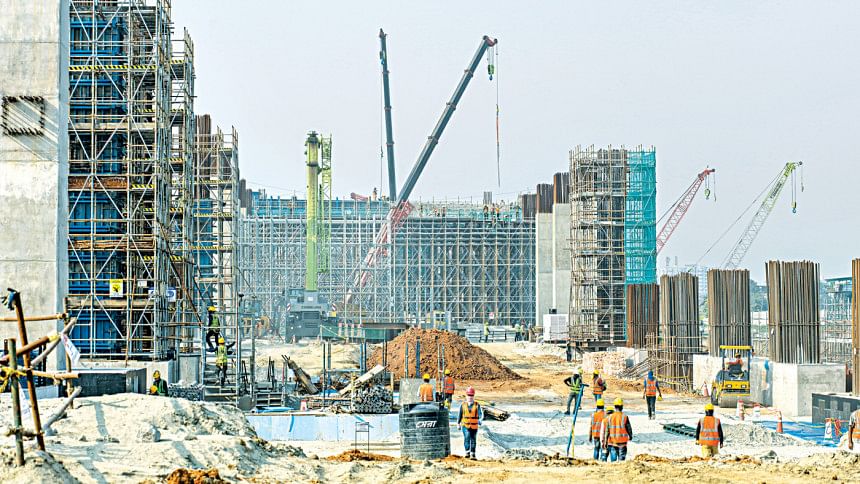Conflict between economic development and environment

Advanced technology-based society emerged in the period following the industrial revolution in the mid-1700s. Several major factors distinguished this new form of society from the previous ones. They are: a marked rise in production and consumption, shift toward synthetics, such as plastics and non-renewable resources—fossil fuel and metals—and huge demand for energy required to keep the wheels of economic development running.
Energy consumption is unquestionably a major factor in the advancement of human civilisation. It has enabled us to manufacture goods, from the primitive iron and bronze implements to the sophisticated computer chips, cell phones, spacecraft, long-haul aircraft, synthetic materials, and many more. Energy facilitates high-speed communication that binds us into one global community. Most significantly, energy enables our planet to support a human population far beyond what would have been possible not long ago.
Ironically, the same energy consumption that brought human society an unprecedented level of comfort and material well-being also threatens Earth's natural systems that maintain a supportive environment. Although our ancestors did plenty of local environmental damage—polluting waters, denuding hillsides, burning forests, perhaps driving species extinct—it is only in the past century that we humans have become so populous, so technologically advanced and so extravagant in our energy consumption, that we have begun to alter Earth's environment on a massive scale.
Economic growth, fuelled by unrestrained use of energy, retained its commanding allure until the mid-19th century. We were caught in an ever-escalating production-consumption cycle with domination of nature as the central theme. The one-sided emphasis on short-term economic gains without concern for adequate environmental protection caused serious environmental pollution and resource shortages.
It is only recently we began to realise that our ability to balance economic development while protecting the environment has been drastically reduced by the environmentally irresponsible and unsustainable behaviour by the Europeans and Americans.
With a fast-growing population striving for better living conditions, the economy of Bangladesh has grown at a tremendous pace over the last two decades. While economic growth has arguably helped the rising population in improving their quality of life, it has also led to deterioration of the natural environment and brought about dramatic changes in the climate. As an example, Bangladesh's graduation from the United Nation's one of the Least Developed Countries (LDC) category to a Developing Country has been achieved at the cost of the health of the country's rivers. Most of the rivers are highly polluted and the main culprit is the flourishing textile sector (readymade garment) which accounts for about 80 percent of the country's total export revenue.
The Rampal and dozen or so power plants Bangladesh government is building near Maheshkhali of Cox's Bazaar invokes the classic battle between development and environment. By deciding to build a coal-fired power plant at Rampal ignoring concerns from national and international environmental organisations, the future of Sundarbans—the most ecologically sensitive and largest continuous mangrove forests in the world—will be in jeopardy. The economic benefits that will result from the construction of the power plant, the prospects of which are doubtful because of rampant corruption, volatile political atmosphere and a history of mismanagement, cannot compensate for the long-term negative effects it will have on the local population and the Sundarbans.

The pollutants from the power plant will cause deforestation which will contribute significantly to global carbon dioxide emissions, reduce biodiversity, cause flash floods and disrupt livelihood of millions of people. Furthermore, it will have an impact on the forest's ability to provide important ecosystem services, namely, functioning as a natural protective barrier against coastal erosion, rising sea levels and killer cyclones.
With more than 100 km of sand, Cox's Bazaar has the world's longest uninterrupted natural beach. To make Cox's Bazaar an attractive tourist destination, trees in nearby hills are being cut indiscriminately and lands are cleared to make room for hotels, restaurants and shops. As a result, frequent landslides during monsoon period are killing many people. In addition, shrinking habitat is endangering wild elephants, forcing them to rampage through villages and neighbouring Rohingya refugee camps. What is more, "planned killing" of these critically endangered species is being carried out in other parts of Bangladesh to illegally occupy forest lands.
Deforestation across the globe has reached an alarming rate in recent years. Undermining pledges to protect forests made at the COP26 climate summit in November 2021, trees are still being cut indiscriminately on the hillside, and lands are cleared to make way for settlements and farms. Cutting and burning forests may release enough plant nutrients to support crops for a few years, but because the soil has little reserve and because nutrients are quickly taken up by crops or washed away, the land quickly falls into ruin. Moreover, cutting down trees exposes the soil to intense rains that wash away the soil, filling nearby streams and rivers with sediment.
Clearing the forest has severe effect on humans, too. When the forest vegetation and its animal population are disturbed or reduced, insects that lived on natural vegetation transfer their attention to man's crops. Some of the parasites of the vanishing animals make the transference to man, like the malaria-carrying mosquito.

As noted above, the engine of economic development is energy, much of which is derived from fossil fuels. But at every step in the extraction of fossil fuels, particularly coal, significant impacts on the environment occur.
When we think of coal mines, we probably picture miners toiling away deep underground. This is the traditional method. Coal is also extracted by strip mining, in which surface layers are removed to reach the coal seam. Obviously, surface mining results in major environmental alteration. It creates eyesores, destroys wildlife habitat and grazing land, and may increase land erosion.
Not too many years ago, strip-mined land was abandoned when coal was gone,leaving behind steep piles of discarded earth alternating with trenches from which the coal had been removed. Because the soil of the abandoned mine is often acidic from minerals leached from the mine, very few plants could grow and the area became a wasteland. Also, acidic runoff from mines, or acid mine drainage as it is called, has rendered nearby streams and rivers lifeless.
Even old-fashioned underground mining has serious implications for the environment and health of the miners. Miners often suffer from black lung disease brought on by exposure to dust-laden air inside the mines.
Underground mines are notorious for explosions and cave-ins, making mining one of the most hazardous occupations in the world. Countries where rapid industrialisation drives a growing appetite for coal averages scores of deaths each year from accidents. Additionally, collapsing mines cause subsidence, a sinking of the surface.
Environmental dangers persist long after mining ends; for instance, accidental fires in abandoned coal mines can burn for years or even decades, threatening communities that have the misfortune to be located above or near the mines. A fire has been burning for over 50 years in a mine in Centralia, Pennsylvania.

Hydroelectric power is a clean renewable source of energy that emits practically negligible amounts of greenhouse gases compared to fossil fuels. Nevertheless, it has substantial environmental impacts, nearly all of which are related to the dams that store water for generation of electricity. Some of those impacts are obvious, while others are subtle. The most obvious impact is to block naturally flowing rivers and turn them into placid lakes. In many countries the lakes have become breeding sites of potentially life-threatening parasitic worms, as in the Aswan Dam in Egypt. The dams also inundate vast areas of nearby land that often necessitate the relocation of entire towns and villages.
Construction is one of the fastest growing sectors in the economy of Bangladesh. Hundreds of buildings—high-rise apartments, shopping malls and office buildings in cities, hotels and restaurants in tourist hot spots, to name a few—have mushroomed in recent years. To feed the booming construction industry, there are approximately 5,000 privately operated brick kilns all over the country, many illegal, with towering smoke stacks belching thick, black plumes of smoke into the sky.
Traditionally, coal is used as fuel for firing clay bricks in the kilns to a temperature close to 1000 degrees Celsius. These kilns emit substantial amount of black carbon, or soot, and other toxic pollutants which are major components of air pollution. According to a study, kilns are responsible for about 15 percent of the country's annual carbon dioxide emissions and in the capital Dhaka, up to half of the fine particulate matter considered harmful to human lungs.
Besides, unchecked and unplanned construction of buildings have adverse impact on the environment. Most importantly, they modify some of the local climatological factors in their immediate vicinity, resulting in a relatively small-scale but tangible variation in the local climate, which is called "urban heat island effect," or more generally microclimate. While microclimate does not produce dramatic changes in temperature, over the years the cumulative effect of these heat sources are clearly noticeable in the average temperatures of 1970s Dhaka and present Dhaka. An extreme example of the effect of microclimate is the city of Kyoto, Japan.
It experienced an increase in mean temperature of 1.8 degrees Celsius between 1880 and 1935, a period of rapid industrialisation and growth. Now 1.8 degrees may seem insignificant, but to put this in perspective, scientific models show that an increase of 5 degrees in the mean temperature of the Earth would be sufficient to melt all remaining ice caps, and raise the ocean level by about 500 feet.
An important function of the environment is to absorb the waste products, including carbon dioxide which originate from the production processes of industries and from power plants, or the waste heat in the form of hot water—an inevitable by-product of power plants—rejected into the source from where water is drawn to keep the equipment cool, or the consumption activities of the households which generate garbage for collection and disposal. Thus, the environment is used as a waste sink.
It is important to note that environment has a limited capacity to absorb these wastes, or to dispose of them safely, or transform them into some harmless substances. For example, adding hot water to the environment, mostly in rivers and lakes, is not the simple act of dilution it might appear to be. It degrades water quality of the source by a process that changes its ambient temperature which not only affects organisms directly, but also the entire ecosystem of the aquatic environment.
Development and environment need to be seen as complementary, not opposite to each other. The economic needs of people will of course continue to demand the development and completion of projects such as the construction of power plants. However, we can continue with our development projects on a purely economic and technological basis, or we can become emotional and bemoan every lost earthworm or crushed ant, while turning a deaf ear to the crying of a hungry child.
The only rational approach is to anticipate the effects of prodigious technology-oriented development projects of the future on the environment. In this way we may preserve some semblance of the natural world. Otherwise, development achieved at the cost of undermining the environmental balance will lose its sheen and a global sustainable society may seem like utopia. Lest we forget, the cost of protecting the environment is less than the cost of reversing effects of environmental destruction.
As the Swedish diplomat and environmentalist Rolf Edberg (1912-1997) reminds us, "The utopia of one generation may be recognised as a practical necessity by the next." It is hoped that the present generation led by the Swedish teen Greta Thunberg with her Fridays for Future movement will make us recognise that sustainability is a practical necessity. After all, we cannot have development if there is no Earth left. We therefore need the Earth and its bounties more than the Earth needs us.
Finally, all of these come down to one fact. The magnitude of humanity's development activities and energy enterprise has become large enough to have a deleterious impact on our planet. Reducing that impact and mitigating its effect will require people who can undertake a serious quantitative analysis of the problem and its potential solutions. It will also take visionaries with new technological, economic and social ideas that can reconcile energy-consuming humanity with a healthy planet. And it will need leaders, scientists, activists and policymakers with the optimism, courage and confidence to guide us through what, by any measure, will be some challenging decades ahead.
Quamrul Haider is a Professor of Physics at Fordham University, New York.

 For all latest news, follow The Daily Star's Google News channel.
For all latest news, follow The Daily Star's Google News channel. 



Comments